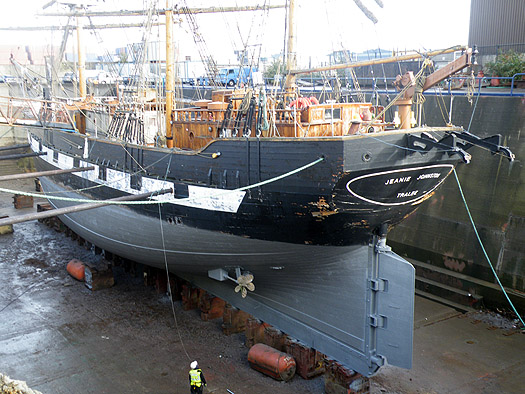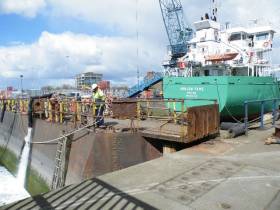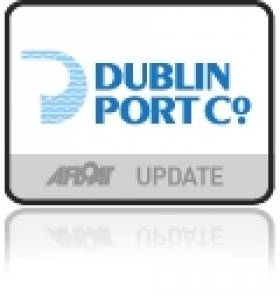Displaying items by tag: Dublin Graving Docks
Closed Dublin Dry Dock Leads to New Business At Recently Upgraded South Wales Facility
#DryDockYards - Following closure of Dublin Graving Docks last year, the main client Arklow Shipping, has been forced to send some short-sea traders elsewhere, which has involved use of the recently refurbished Swansea Drydocks Ltd in south Wales, writes Jehan Ashmore.
According to SDL, Arklow Raider had the honour as the first cargoship to use the extensively upgraded facility which was taken over by the company. The 4,933dwt cargoship dating to 2007 belongs to a combined 50-plus mixed flagged fleet under the Irish and Dutch flags respectively. The latter flagged fleet are managed by ASN B.V. of Rotterdam.
The dry docking period of the Irish flagged Arklow Raider was first noted by Afloat last month when the near 90m cargoship had occupied the larger Prince of Wales dock (no.1) which is at 204.5m in length. This dry dock though is smaller when compared to what the Dublin facility had to offer with the 220m dry dock. The facility which used to have two dry docks, closed last year though an exception was made earlier this year to facilitate a much needed overhaul of the timber built tallship, Jeanie Johnston.
The second dry dock in Swansea at 170m is adjacent within the King's Dock system of three basins from where the facility is accessed through a lock from the port's channel leading to the River Tawe. Located close to where the loch entrance is where Fastline Line had operated the last Swansea-Cork ferry service until 2011. The Irish owned company had operated from the terminal built originally for the B+I Line that was served by ferries, among them the Connacht (built 1978), see related report.
Commenting to Afloat on the major investment, Garth Masterson, G.M., Swansea Drydocks Ltd said "the work involved bringing the 2 drydocks back to there full working potential.Since the take over we have refurbished no 1 drydock caisson with all new sealing timbers which enabled us to start drydocking vessels in the last few months, we are now in the process of renewing steel to no 2 gates and getting workshops ready".
The port of Swansea operated by Associated British Ports (ABP) has a long history of ship repair that dates back to the early 20th century. The reopening of the business by SDL saw a long term lease signed with ABP and this will utilisise the port’s geographical position to dry dock vessels up to 35,000 dwt and primarily operating in northern European waters. This trading area is particular covered by Arklow Shipping.
In addition SDL offers a complete lifecycle service that includes surveys, ongoing maintenance, repairs, and the recycling of end of life vessels which has Afloat will have more to report on.
Upon completion of works of the Arklow Raider, the short-sea trader sailed across the Bristol Channel to Portbury (Port of Bristol). From there a passage on the Celtic Sea was made with Afloat tracking the ship's arrival off Cork Harbour at the end of the same month. The cargoship then made a coastal passage to Limerick Docks where Afloat also noted on Monday this week another R class, Arklow Raven also share the Ted Russell Docks close to the city-centre's main throroughfare O'Connell Street.
Also down the estuary anchored close to the Mouth of the Shannon were further ASL Irish flagged ships but of differing F and M classes represented by Arklow Falcon and bulk carrier Arklow Manor.
Also tracked by Afloat on Monday, was yet another R class sister, the Dutch flagged Arklow Rally that was at SDL's Prince of Wales No.2 dry dock. The cargoship is only one of two dating to 2002 and as such are the oldest tonnage in the entire fleet. It was noted the following day that a name change had taken place to Celtic Freedom and transfer to the UK flag. Afloat will have more to report on this development.
As of this morning, further tracking again focusing on Swansea noted that Arklow Raider departed Limerick and had returned to the Welsh port.
#Lamentable – The decision to close the largest graving dock in the state in Dublin Port has been described as ‘lamentable’ by the Maritime Institute of Ireland, writes Jehan Ashmore.
According to the M.I.I.’s latest biannual newsletter, the Institute expresses concern that the closure could result in work being lost to Ireland “with the lamentable decision to close and in-fill the big Dublin Graving Dock No.2 which was in constant use by Arklow Shipping”.
It is almost exactly six months ago that Afloat.ie reported the closure of the country’s largest drydock, at 220m long. The ship-repairer and conversion firm, Dublin Graving Docks ceased operations officially on 29 April with the loss of a skilled labourforce of 26 marine engineering personnel. The business had been operated by DGD under license from the Dublin Port Company.
The Institute added “this valuable overhaul and survey work would be lost to the State. It is the biggest such facility in the Republic and was opened in 1957 in style by the then President Sean T.O’Kelly as befitted such an iconic State-funded enterprise”.
Furthermore, in the Autumn newsletter article, the Institute said hopefully, wise counsel will prevail and this valuable maritime facility will be retained on the east coast in the country’s major port.
The last ship, however to use the facility, was aptly an Irish flagged cargoship, Arklow Fame (pictured above) that occupied the graving dock before floated-out on 27 April.
Dublin Port Company are to incorporate the graving dock by infilling to make additional quay frontage and cargo space for the €227m Alexandra Basin Redevelopment.
The ABR project is to enable considerably larger deep drafted cargoships to enter the port. In addition to accommodate giant cruiseships by berthing much closer to the city-centre.
The newsletter also commented that Arklow Shipping has since seemed to be trying out Cork Dockyard. It the next largest such facility in this state which received former business of DGD through the Arklow Rose, which Afloat first highlighted in July.
This former Dutch flagged member of the ASL fleet however upon completion of drydocking emerged as Celtic Venture having been sold to UK based owners.
#JeanieJohnston - Jeanie Johnston departed Dublin Graving Docks today following the replica 19th barque's most extensive maintenance work since her purchase by the DDDA more than a decade ago, writes Jehan Ashmore.
She is scheduled to resume her famine emigrant museum ship role with tours starting this Saturday (1 November).
Among the work carried out by the dockyard which faces closure as previously reported, was cleaning of her hull, removal of debris notably along the waterline and timber replaced where necessary in addition to repainting.
Graving Dock No.2 was flooded to allow the replica tallship to vacate from the Alexandra Basin based ship-repair facility with tug assistance to her current lay by berth next to the East-Link Bridge.
She will then continue her final short leg upriver with a transit also involving the opening of the Samuel Beckett swing –bridge to moor along her usual Custom House Quay berth.
The visitor attraction which had 20,000 visitors to date this year, tells the story of the famine and the emigrant carrying barque whuch sailed to the New World. Between 1848-1855 she carried more than 2,500 people from Ireland on 16 crossings to North America.
A bonus for the museum ship has been a rise in Canadian tourists due to more flight capacity. They are drawn to the museum ship as the original Jeanie Johnston was built in Quebec in 1847 along the St. Lawrence River.
#JeanieJohnston - Jeanie Johnston which is undergoing maintenance at Dublin Graving Docks Ltd was joined this week by Dutch flagged Arklow Rambler at the ship-repair facility that faces closure by Dublin Port Company over plans to redevelop Alexandra Basin, writes Jehan Ashmore.
As previously reported, Dublin Graving Docks which employs around 26 people at a site within the port estate area of Alexandra Basin is where DPC propose a €200m project to accommodate much bigger cruise ships at a dedicated terminal as outlined at a recent planning hearing by An Bord Pleanála.
Dublin Graving Docks which operates the port-owned 200m long graving dock is the only ship-repairer and conversion business left remaining in the country's largest port.
However the Alexandra Basin Redevelopment (ABR) project (see website) for cruise berths would also involve a reconfiguration of other berths throughout the basin. In addition the plans are to enable larger deep-drafted cargoships and more quayside space to include the site of the dry dock.
Currently trade throughput is around 29 million tonnes though the port's strategy is to plan ahead so to handle 40 million tonnes by 2040. This is where the ABR forms phase one of the Dublin Port Company's Masterplan (2012-2040) which sets out the future of the port over the next four decades.
Jeanie Johnston is a replica 19th century barque based on the original built in Quebec Canada in 1847 that transported 2,500 people to North America. Since her acquisition by Dublin Docklands Development Authority (DDDA) in 2005, she has been dry-docked twice at the nearby facility.
The DDDA brought the Tralee registered tallship as part of a river regeneration project and appointed Aiseanna Mara Teoranta on their behalf to operate the vessel as a tourist attraction.

Jeanie Johnston, the replica 19th century barque is undergoing her most extensive maintenance dry-docking since DDDA's purchase in 2002. She is seen as a fresh layer of primer paint is applied to her timber hull. Photo Jehan Ashmore
Last year she welcomed 20,000 visitors and this year there has been a rise in Canadian tourists due to more flights to Ireland, in which they have heard the story on board of how Irish emigrants fled the famine and sought a better life in the New World.
As she lays in Graving Dock No.2, this is a far removed environment to her role at her berth close to the Convention Centre.
Her maintenance programme requires intensive cleaning of her hull, removal of debris notably along the waterline and any replacement of timber plus applying layers of paint. On completion of the work she is to return shipshape and resume her museum role on 1 November.
Dry Dock Workers Face Job Loss over Dublin Port Plan
#DryDockJobs - The Irish Times reports that a dry dock employing some 26 workers face losing their jobs as a result of a €200m plan by Dublin Port Company to redevelop Alexandra Basin to accommodate bigger cruise ships, a planning hearing has heard.
Half a dozen shipping workers (yesterday) protested outside the hearing by An Bord Pleanála in Dublin city centre. The services they provide include ship repair, maintenance, and marine mechanical and electrical engineering.
Joe Nelson, company secretary of Dublin Graving Docks Ltd reported said the company was not against cruise ships but was against the configuration and the scale of the proposal.
The reason given for the closure of the dry dock area where the company was based was the financial yield per acre of land to Dublin Port, he said. For more on this story, click HERE.
Afloat.ie adds that Jeanie Johnston which is to undergo essential maintenance, has since moved again within Alexandra Basin from the lead-in jetty as previously reported to enter the graving dock operated by Dublin Graving Docks.


































































